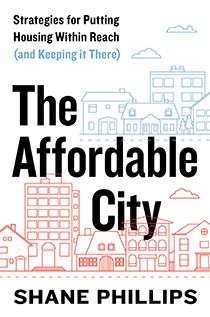Affordable City: Strategies for Putting Housing Within Reach (and Keeping It There)

In September 2022, the median home sales price in the Charlotte region was $380,000, according to the Canopy Realtor Association. And a search on Rent.com for Charlotte rentals listed for $1,000 or less per month resulted in only 46 properties of 1,769 total (or 2.6%). Our region has a growing housing affordability problem.
Unfortunately, the challenge of affordable housing isn’t limited to Charlotte. City residents across the country face rising prices and rents. But fortunately, this national problem has attracted the attention of thoughtful people like Shane Phillips, whose book The Affordable City provides a thorough, solutions-focused examination of the issue.
 Phillips is the Housing Initiative Project Manager at the UCLA Lewis Center for Regional Policy Studies. His book is an easy and engaging read—anyone with an interest in housing policy should read it. Phillips starts off with high-level principles and strategies for improving housing affordability and then proceeds to offer a series of strategies organized around three distinct priorities (more on these in a bit). Most of the recommended policies could be adopted by local governments, but some of Phillips’s advice is directed at states and the federal government.
Phillips is the Housing Initiative Project Manager at the UCLA Lewis Center for Regional Policy Studies. His book is an easy and engaging read—anyone with an interest in housing policy should read it. Phillips starts off with high-level principles and strategies for improving housing affordability and then proceeds to offer a series of strategies organized around three distinct priorities (more on these in a bit). Most of the recommended policies could be adopted by local governments, but some of Phillips’s advice is directed at states and the federal government.
As someone who is deeply entrenched in affordable-housing policy and activism (particularly in California), Phillips is sensitive to a key philosophical difference in approaches to affordable housing. On one side, supply-side-focused “market urbanists” focus their recommendations on relaxing restrictions that make it hard for developers to increase housing supply to meet rising market demand. On the other side, advocates for low-income residents (especially tenants) argue for laws and regulations to strengthen renters’ bargaining power vis-à-vis landlords.
Both sides want more affordable housing. But they differ—sometimes acrimoniously—over how best to accomplish their shared goal. Phillips views the rivalry between these factions as counterproductive. One of his goals in writing the book is to harmonize affordable housing groups so that they work in concert to improve housing outcomes instead of engaging in distracting debates that only serve the status quo.
Phillips thus takes an “all of the above” approach to housing policy. He embraces the values, assumptions, and conclusions of both market urbanists and tenant advocates, and he argues that meaningful progress will require us to embrace multiple priorities.
Phillips highlights three major priorities for affordable housing policy. He calls them the “Three S’s”:
- Supply: the notion that policy should provide for (or at least allow for) an abundance of housing;
- Stability: the idea that policy should provide people with housing security such that residents (especially tenants) do not have to constantly worry about being displaced or facing dramatic increases in their rent; and
- Subsidy: the view that the government should step in to fund housing needs that are not (and never can be) satisfied by free, competitive markets.
Within each section, Phillips offers many policy strategies. For example, among the “Supply” recommendations are upzoning (increasing the density and intensity of permitted uses), increasing mixed-use districts, eliminating parking minimums, and allowing more development by right (as opposed to requiring discretionary approval). These recommendations most obviously pertain to local governments’ land-use policies.
The “Stability” strategies are focused on protecting the rights of tenants and preserving the stock of rental housing. Some of these policies could be adopted by local governments, but—in Dillon’s rule states like North Carolina—some of these policies would probably require clearer delegations of authority to municipalities from the state.
The “Subsidy” section considers the role governments—local, state, and federal—could and should play in the provision of housing. People need secure housing to be productive. But beyond that, housing is a basic human need, which means that compassionate societies are unwilling to simply shrug when markets leave some people without safe, adequate housing. We feel an obligation to fill the gap between what’s needed and what’s available. Government can and does play an important role in providing this backstop. But poorly designed policy doesn’t help—and sometimes makes things worse. We want to make sure that our policy interventions are carefully calibrated to advance the ultimate goal of providing housing to everyone as efficiently as possible.
Phillips does that. His book offers fifty-four strategies in all. Some are general recommendations about how to think about housing, and some are specific policies. Phillips’s descriptions of the strategies are brief and clear. You need not read the entire book from start to finish—you can peruse the mini-chapters in any order and focus on strategies of particular interest to you. And Phillips makes clear that he does not expect any city anywhere to adopt all of his recommendations. He’s offering a series of discrete policies and strategies, not a comprehensive framework in which every piece fits neatly into a complicated overall superstructure (though Phillips does believe his strategies mutually reinforce each other).
Phillips has created an excellent resource for a variety of readers. Novices will learn a great deal about how housing markets and housing policy work separately and together. The short appendix is a particularly useful primer. Experts will find a helpful list of policy interventions to consider. Phillips grounds the book in recent, high-quality work, including thirty pages of notes listing cited sources. The book is a valuable contribution to the national conversation on affordable housing.
Nevertheless, I don’t find the “Stability” section as persuasive as the other two parts of the book. To be clear, that’s not because I disagree with the moral and practical cases for providing housing stability to more people. Rather, I’m skeptical that all of the recommendations Phillips puts forward are the best way to achieve that worthwhile objective.
Phillips lists strategies like rent stabilization, inclusionary zoning, permanent affordability covenants, and rental housing preservation as ways to prevent landlords and developers from displacing low-income tenants. That’s an admirable goal, and such policies would work to protect the ability of current tenants to stay where they are, if they so desire. But that stability comes primarily at the expense of future tenants, not landlords.
That is, the policies might preserve the existing stock of affordable housing, but they may also dis-incentivize the creation of additional affordable housing stock, which is essential for regions, like Charlotte, with a growing population. In fact, the strategies would likely have negative effects on the supply of housing (particularly affordable housing), worsening the problem of affordable housing for prospective tenants in the years to come. In a growing region like Charlotte, that’s a major concern.
Other recommendations from Phillips’s “Stability” section—like increasing transparency in rental markets (especially with regard to evictions), providing legal counsel to tenants facing eviction, requiring just cause for evictions, protecting against source-of-income discrimination, and purchasing naturally occurring affordable housing (an idea that might fit better under Phillips’s “Subsidy” priority)—are policies worth exploring.
The Charlotte region is facing a growing affordable housing problem. This challenge is urgent, because of human need and because it is easier to slow the rise of prices and rents than to bring them back down. Phillips offers a wide range of reasonable, achievable policies that Charlotte and its neighbors should carefully consider if they truly want to be “affordable cities.”